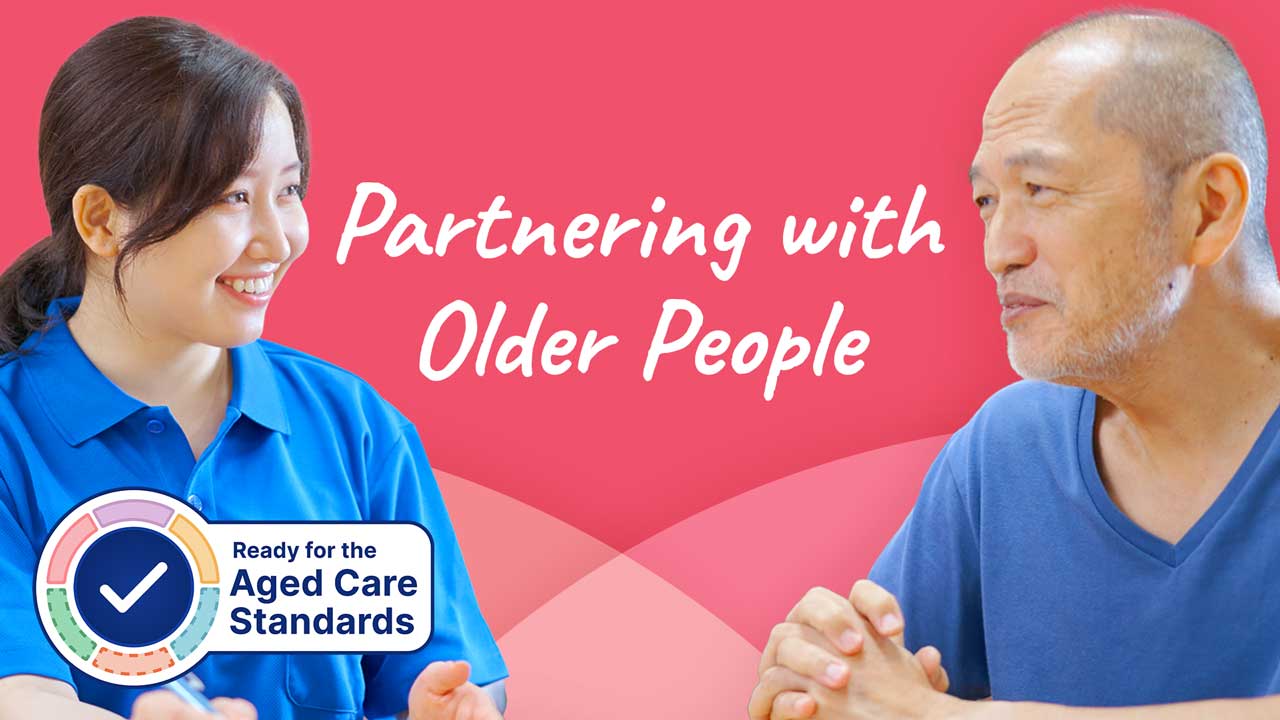Partnering with older people is more than just a buzzword - it’s a fundamental right. Being able to make decisions about our own lives and having those decisions respected is something that the Aged Care Quality and Safety Commission (ACQSC) is ensuring that all aged care recipients are provided (2023).
Partnering in aged care is about working alongside older people to tailor care that respects their individual preferences and goals. From simple conversations to structured forums and systems for feedback, this article considers how providers can effectively partner with older people in their care.
What is Partnering With Older People?
Providers are expected to work alongside older people in order to plan care and services that meet their needs, goals, and preferences (ACQSC 2023).
Even if an older person is experiencing challenges in their life, providers should support them to achieve their goals and live meaningfully while maximising their quality of life (ACQSC 2023).
Partnering with clients involves communicating with the person about their preferences, assessing their abilities, and then delivering care that allows them to fulfil their goals. Plans should be regularly reviewed in order to identify changes in the person’s circumstances and adjust care and services accordingly (ACQSC 2023).
Working in partnership with older people and empowering them to actively participate in planning their care is an essential component of person-centred care (ACQSC 2024a).
Partnerships can be facilitated through:
- Forums
- Meetings
- Feedback sessions
- Surveys
- Research and information analysis on a variety of older people’s perspectives.
(ACQSC 2024b)
Partnering With Older People Under the Strengthened Aged Care Quality Standards
Partnering with older people is an essential concept in the strengthened Aged Care Quality Standards.
Under Standard 1: The Person - Outcome 1.1: Person-centred care:
- Action 1.1.2 requires providers to consider older people’s background, culture, diversity, beliefs and life experiences when planning care.
- Action 1.1.4 highlights the importance of working in partnership with older people to deliver care and services.
(ACQSC 2024b)
Standard 2: The Organisation - Outcome 2.1 Partnering with older people aims to ensure the organisation is actively collaborating with the older person to guarantee ongoing and meaningful improvement. It focuses on the key concepts of:
- Partnering directly with older people
- Facilitating older people's participation in partnerships
- Collaborating with older people on governance matters
- Recognising the diversity among service-using older people, especially those at greater risk of harm, in order to provide them with individualised information
- Engaging in partnerships with diverse older populations, including Aboriginal and Torres Strait Islander people.
(ACQSC 2024c)
Under Standard 3: Care and Services:
- Outcome 3.1: Assessment and Planning
- Action 3.1.2 highlights the importance of ongoing communication and partnership with older people and their loved ones during assessment and plannin
- Outcome 3.2: Delivery of care and services
- Action 3.2.6 requires providers to implement a system for older people living with dementia that allows the person’s family, carers and health professionals to participate in the planning and delivery of care (in accordance with the older person’s wishes).
- Outcome 3.4: Coordination of care and services
- Action 3.4.1 requires providers to partner with older people to facilitate coordination and continuity of care with other parties involved in the person’s care.
- Action 3.4.2 recognises carers as partners in older people’s care and involves them in coordinating care and services.
(ACQSC 2024d)
What Might Partnering With Older People Involve?
- Assessing the older person’s functional abilities and determining what assistance they may need to optimise their quality of life
- Listening to the older person’s goals and preferences and determining how these can be fulfilled
- Taking the older person’s personal and cultural preferences into account in order to appropriately personalise the care and services delivered
- Supporting the older person to participate in planning as little or as much as they would like
- Providing adequate information to the older person so they can make informed decisions
- Asking for feedback from the older person
- Communicating and liaising effectively with other providers involved in the older person’s care.
(ACQSC 2023)

Getting to Know the Person
Taking a person-centred approach means being a good listener and understanding what the older people in your care want to gain from their own lives. Your role is to explore options and solutions to guide them towards their goals rather than enforcing what you think is best for them (Donna 2019).
Consider the person’s:
- Experiences
- Interests
- Employment
- Religion
- Cultural background
- Likes and dislikes
- Values
- Sources of happiness
- Hobbies
- World views.
(Donna 2019)
Care Plans
Partnering with older people, their loved ones, and other parties involved in their care is an important part of care planning and review (ACQSC 2024a).
The outcomes of assessment and planning are expected to be documented in a care and services plan, which should be kept accurate and current. A care and services plan may comprise one or several documents and should be available to both the provider and older person when needed (ACQSC 2023).
The plan should include the person’s needs, goals, and preferences and may also include advance care planning (ACQSC 2023).
The goal of care plans is to:
- Ensure the person feels understood and heard
- Give clear directions on a person’s care
- Coordinate all parties involved in a person’s care, e.g. nurses, care workers, allied health professionals
- Keep track of the person’s care needs.
(Gramenz & Dymock 2023)
Care plans must be readily available to the person and their loved ones (Gramenz & Dymock 2023).
The provider and older person should agree on a review date for the care plan depending on the person’s needs and the services being provided (ACQSC 2023).
Long-term Planning
Part of planning with older people means providing them with resources and support to complete end-of-life planning and advance care directives if they wish to do so. This will allow the person to inform their end-of-life experience, saving carers, staff, and loved ones from unnecessary distress if the discussion is left too late (ACQSC 2023).
If the person does not have decision-making capacity, their designated substitute decision-maker can assist in developing an emergency care plan (ACQSC 2023).
Once completed, this documentation is expected to be accurate, up-to-date, and properly stored (ACQSC 2023).

Emergency Planning
Providers should work together with older people receiving care and services at home to develop an emergency plan. As the carer may not always be present, it’s essential that the older person knows what to do in such a situation.
- Encourage the older person to consider advance care planning.
- Ensure advance care documentation can be retrieved quickly and easily.
- Ensure any advance care documentation accompanies the older person if they need to be transferred to a different care setting.
- Liaise with the older person’s general practitioner if you have concerns about their health.
- Inform carers about the Carer Gateway emergency plan. In the event of an emergency that incapacities the carer, this document will help somebody else quickly take over to care for the older person.
- Encourage the older person or their loved ones to compile a list of emergency contacts and leave it in an easily accessible location.
(palliAGED 2021)
Setting Goals
A key component of planning care with older people is identifying and setting goals that reflect their personal and clinical needs, preferences, expectations, and aspirations. Goal-setting improves people’s satisfaction, quality of life, and self-efficacy (ACSQHC 2019).
While a conversation with the client about their values and preferences may suffice at a minimum, you may also utilise tools, frameworks, models, or person-centred communication models in order to identify goals. These goals should then be used to inform the older person’s care (ACSQHC 2019).
The following principles should be used when identifying and setting goals:
- Set aside time to discuss what is important to the person
- Make decisions about goals together with the person
- Identify several goals that are positive and achievable but challenging
- Clarify the roles and responsibilities involved in achieving these goals
- Clearly communicate and document the goals that have been agreed upon
- Track progress and measure achievement against the goals
- Understand that the goals may require repetition in order to be achieved
- Integrate the goals into existing care systems and processes.
(ACSQHC 2019)
Reviewing Plans
Providers are expected to regularly review care plans to ensure:
- The plans are up-to-date and adequately meet the person’s needs, goals and preferences
- Care and services are meeting the person’s needs safely and effectively
- Care and services are improved or updated when possible.
(ACQSC 2023)
Plans should be reviewed when:
- It is the agreed review date, as documented on the plan
- The person’s condition (e.g. physical or mental health) changes
- A situation (e.g. organisation’s arrangements) changes
- An incident or accident occurs.
(ACQSC 2023)
Test Your Knowledge
Question 1 of 3
Which one of the following is a goal of care plans in aged care settings?
Topics
Further your knowledge
References
- Aged Care Quality and Safety Commission 2024b, Standard 1: The Individual, Australian Government, viewed 9 April 2024, https://www.health.gov.au/resources/publications/strengthened-aged-care-quality-standards-august-2025?language=en
- Aged Care Quality and Safety Commission 2024c, Standard 2: The Organisation, Australian Government, viewed 9 April 2024, https://www.health.gov.au/resources/publications/strengthened-aged-care-quality-standards-august-2025?language=en
- Aged Care Quality and Safety Commission 2024d, Standard 3: Care and Services, Australian Government, viewed 9 April 2024, https://www.health.gov.au/resources/publications/strengthened-aged-care-quality-standards-august-2025?language=en
- Aged Care Quality and Safety Commission 2024a, Draft Worker Guidance: Guidance Material for the Strengthened Aged Care Quality Standards for Review and Discussion, Australian Government, viewed 9 April 2024, https://www.agedcarequality.gov.au/resource-library/draft-guidance-aged-care-workers
- Aged Care Quality and Safety Commission 2023, Guidance and Resources for Providers to Support the Aged Care Quality Standards, Australian Government, viewed 9 April 2024, https://www.agedcarequality.gov.au/resources/guidance-and-resources-providers-support-aged-care-quality-standards
- Australian Commission on Safety and Quality in Health Care 2019, Implementing the Comprehensive Care Standard: Identifying Goals of Care, Australian Government, viewed 9 April 2024, https://www.safetyandquality.gov.au/sites/default/files/2019-06/implementing-the-comprehensive-care-standard-identifying-goals-of-care-final-accessible-pdf-24-apr-2019.pdf
- Donna 2019, ‘We’re All In This Together’ – Ongoing Assessment and Planning|New Aged Care Standard #2, Culturally Directed Care Solutions, viewed 9 April 2024, https://cdcs.com.au/standard-two-new-aged-care-standards/
- Gramenz, J & Dymock, J 2023, What is a Care Plan in Aged Care?, St Vincent's Health Australia, viewed 9 April 2024, https://www.svcs.org.au/residential-aged-care/information/care-plans-aged-care
- palliAGED 2021, Emergency Planning and Management, PalliAGED, viewed 9 April 2024, https://www.palliaged.com.au/tabid/4489/Default.aspx
 New
New 

